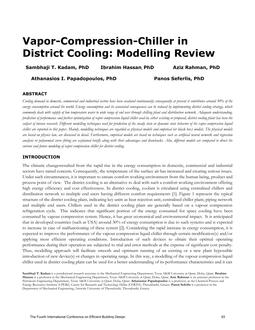
Vapor-Compression-Chiller in District Cooling: Modelling Review
- Comments Off on Vapor-Compression-Chiller in District Cooling: Modelling Review
- ASHRAE
Click here to purchase
Cooling demand in domestic, commercial and industrial sectros have been escalated continuously; consequently at present it contributes around 30% of the energy consumption around the world. Energy consumption and its associated consequences can be reduced by implementing district cooling strategy, which commonly deals with supply of low temperature water to wide range of end user through chilling plant and distribution network. Adequate understanding, prediction of performance and further optimization of vapor compression liquid chiller used in, either existing or proposed, district cooling plant has been the subject of intense research. Different modelling techniques used for prediction of the steady state or dynamic state behavior of the vapor compression liquid chiller are reported in this paper. Mainly, modelling techniques are regarded as physical models and empirical (or black box) models. The physical models are based on physics law, are discussed in detail. Furthermore, empirical models are based on techniques such as artificial neural network and regression analysis or polynomial curve fitting are explained briefly along with their advantages and drawbacks. Also, different models are compared to direct the current and future modeling of vapor compression chiller for district cooling.
Citation: 4th Intl Conf: Efficient Bldg Design
Product Details
- Published:
- 2020
- Number of Pages:
- 10
- Units of Measure:
- Dual
- File Size:
- 1 file , 1.9 MB
- Product Code(s):
- D-ICEB20-12

